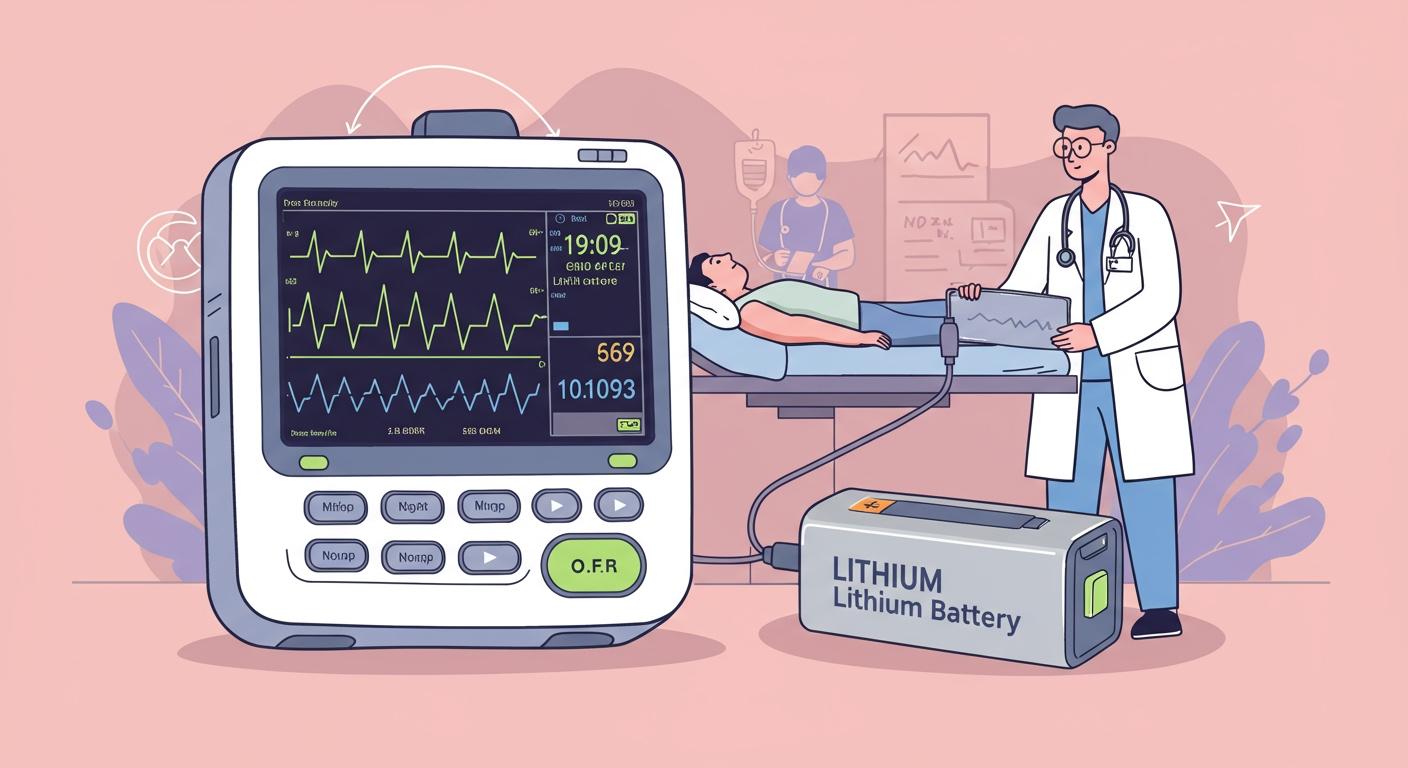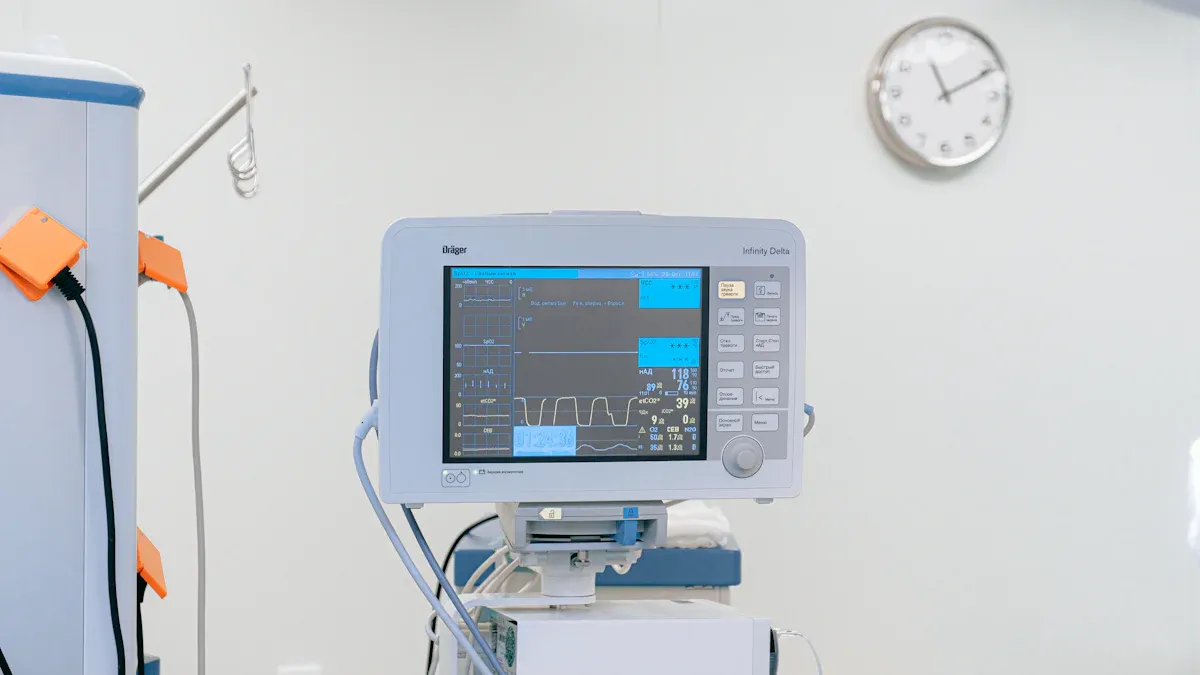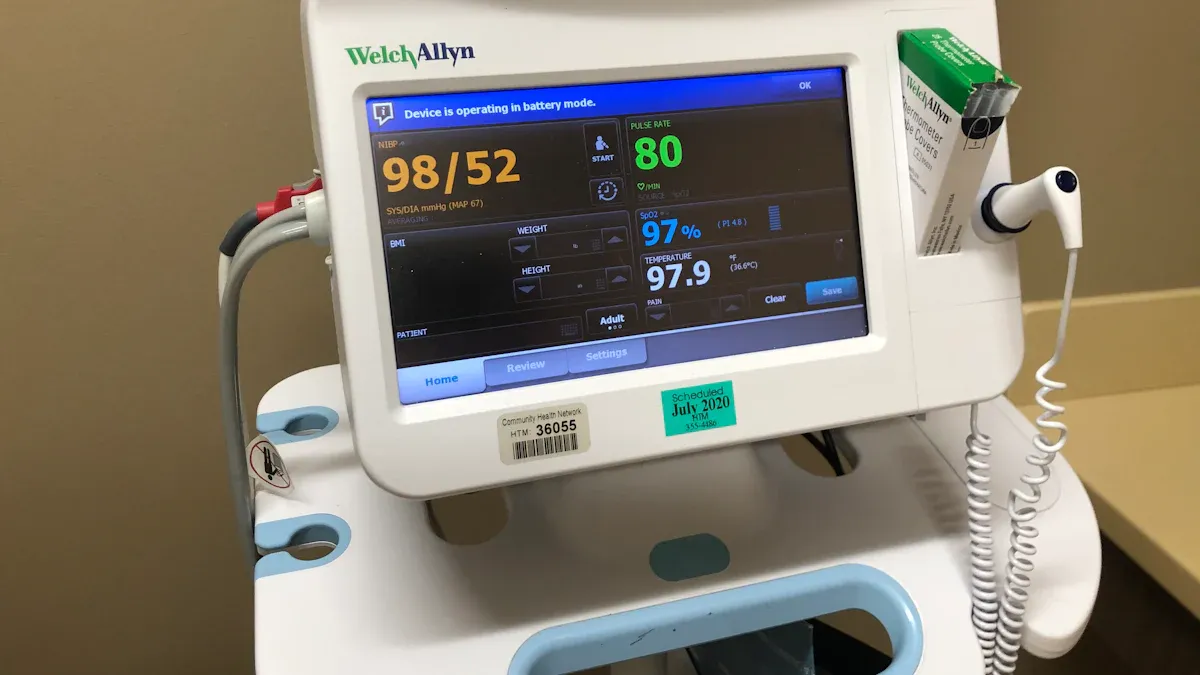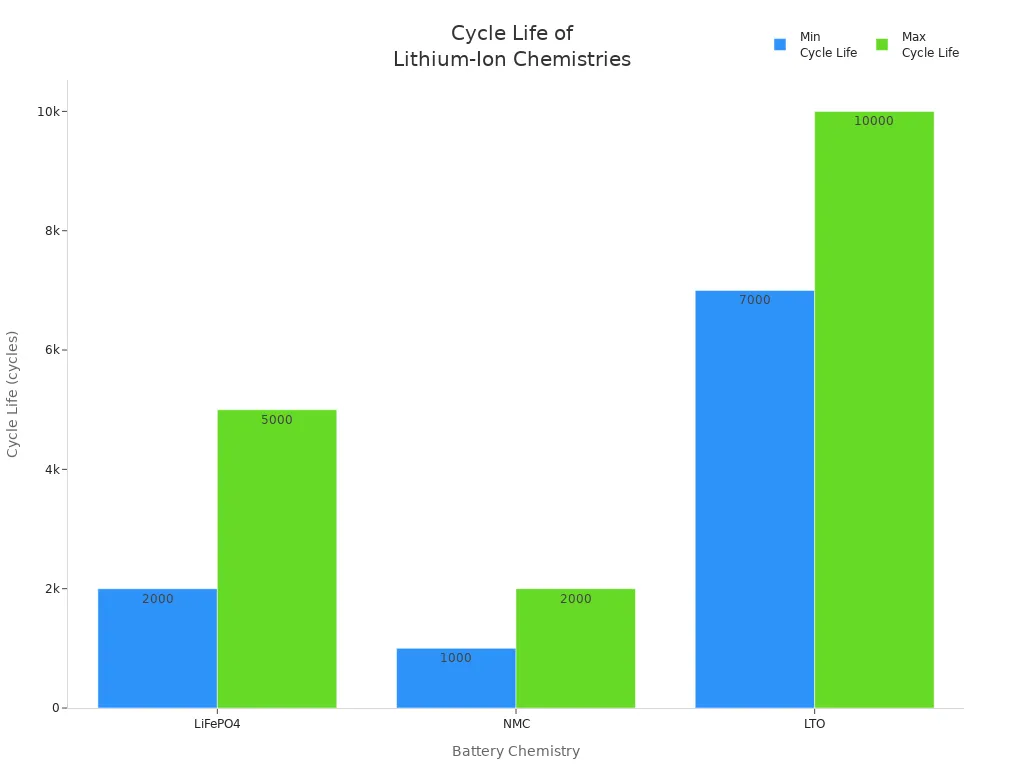
Lithium-ion batteries have changed how you use portable patient monitors. Their high energy density, reliability, and long lifespan allow you to monitor patients for longer periods without frequent charging.
In 2023, lithium-ion batteries made up 50.73% of the medical battery market, with rapid growth expected due to their advantages.
Aspect | Impact |
|---|---|
Device Uptime | Longer operational times on a single charge for critical devices like ventilators and pumps. |
Portability | Compact design allows for easier transport and use in various clinical environments. |
Patient Care Outcomes | Reliable power sources improve the functionality and safety of medical devices. |
Hospitals that switched to lithium battery packs saved millions over several years by reducing replacements and maintenance.
Key Takeaways
Lithium-ion batteries enhance portable patient monitors by providing longer device uptime, reducing the need for frequent recharging.
Advanced battery management systems ensure safety and reliability, preventing issues like overcharging and thermal runaway.
Continuous monitoring with portable devices leads to better patient outcomes, including reduced hospital stays and lower chances of ICU transfers.
Part 1: Portable Patient Monitors in Healthcare

1.1 Device Overview
You rely on portable patient monitors to track vital signs and health metrics in real time. These devices have become essential in hospitals, clinics, and even remote care settings. You can choose from several types, each designed for specific functions:
Heart Rate Monitor – Tracks heart rate.
Respiratory Rate Monitor – Measures breathing rate.
Blood Pressure Monitor – Monitors blood pressure levels.
Temperature Monitor – Checks body temperature.
Oxygen Saturation Level Monitor – Measures oxygen in the blood.
Blood Glucose Monitor – Useful for diabetic patients.
ECG Monitor – Records electrical activity of the heart.
You will find low acuity monitors for basic checks, medium acuity monitors for more detailed tracking, and high acuity monitors for critical care. These portable patient monitors support quick decision-making and allow you to respond rapidly to changes in a patient’s condition.
1.2 Clinical Importance
Portable patient monitors play a key role in improving patient safety and outcomes. You benefit from continuous monitoring, which provides real-time data and supports timely interventions. The table below highlights how these devices contribute to better care:
Evidence Type | Description |
|---|---|
Real-time Data | Continuous monitoring enables faster response and better management. |
Interoperability | Devices communicate with each other, reducing errors and improving workflow. |
Infection Control | Easy-to-clean designs help prevent hospital-acquired infections. |
You can achieve better results with continuous monitoring compared to intermittent checks. Studies show that patients monitored continuously have lower odds of ICU transfer or death—almost three times lower than those with intermittent monitoring. You also help reduce hospital stays and prevent unplanned readmissions by using portable patient monitors. These healthcare devices support remote monitoring, which increases patient mobility and enables care in rehabilitation centers or at home.
Part 2: Lithium-Ion Batteries in Medical Devices

2.1 Energy Density and Reliability
You depend on lithium-ion batteries for reliable energy storage solutions in medical devices powered by lithium-ion batteries. These batteries deliver high energy density, stable voltage output, and long cycle life. You can see how lithium-ion batteries compare to other chemistries in the table below:
Feature | Lithium-Ion | NiMH | Lead-Acid | Sodium-Ion |
|---|---|---|---|---|
Energy Density | ★★★★☆ | ★★☆☆☆ | ★☆☆☆☆ | ★★☆☆☆ |
Stable Voltage Output | High | Moderate | Low | Moderate |
Long Cycle Life | Up to 3,000 | 500-1,000 | 200-300 | 1,000 |
Lithium-ion batteries provide superior energy storage solutions for medical, robotics, security, and industrial sectors. You benefit from longer battery life and fewer interruptions during patient monitoring. The stable voltage output ensures consistent device performance, which is critical in healthcare settings.
Tip: High energy density allows you to design compact devices that are easier to transport and use in various clinical environments.
2.2 Battery Life and Efficiency
You need batteries that last through long shifts and emergencies. Lithium-ion batteries offer impressive cycle life, which reduces maintenance and replacement costs. The chart below shows the cycle life of common lithium-ion chemistries:

Chemistry | Cycle Life (cycles) |
|---|---|
LiFePO4 | 2,000–5,000 |
NMC | 1,000–2,000 |
LTO | 7,000–10,000 |
You must follow proactive maintenance schedules. Manufacturers recommend replacing lithium-ion batteries every year or two to prevent failures. Efficient battery usage extends operational time, which is vital for continuous monitoring. Low-power designs and components allow you to create smaller, more portable devices.
Evidence | Explanation |
|---|---|
Efficient battery usage extends operational time | You can monitor patients without frequent recharging, which is crucial in emergencies. |
Low-power designs enable smaller form factors | Smaller devices improve portability and usability in clinical settings. |
Use of low-power components | Devices operate longer on a single charge, supporting patient care and safety. |
You must comply with fda and IEC 62133 standards to ensure safety and reliability. These standards address thermal runaway, overcharging, and labeling. Compliance builds trust and helps you access global markets.
Aspect | Description |
|---|---|
Standard Name | IEC 62133 |
Focus | Safety testing for lithium-ion batteries used in medical devices and other applications. |
Key Safety Issues Addressed | Overcharging, over-discharging, short-circuiting, thermal runaway, and labeling/documentation. |
Impact on Device Design | Ensures batteries are designed to minimize risks of fire or explosion, enhancing overall safety. |
Global Compliance | Helps manufacturers meet international safety regulations, facilitating market access. |
Consumer Trust | Compliance builds consumer confidence in battery safety and reliability. |
You can learn more about battery management systems and their role in safety at BMS and PCM. For scientific advancements in battery technology, visit Nature.
Part 3: Impact on Portable Patient Monitors
3.1 Uptime and Performance
You depend on portable patient monitors to deliver uninterrupted real-time health data in critical environments. The efficiency of lithium-ion batteries and li-ion batteries directly impacts device uptime. These batteries last longer than conventional options, so you replace them less often. You benefit from integrated electronic fuel gauges and safety protection circuits, which extend battery life and reduce maintenance needs.
Lithium-ion batteries typically last 8-10 years, often outlasting the devices they power.
You experience fewer battery replacements, which lowers maintenance costs.
You can service multiple units at once, streamlining operations in busy healthcare settings.
Li-ion batteries provide stable voltage output and high energy density. You see consistent performance in medical devices, robotics, security, and industrial sectors. You rely on these batteries to keep monitors running during long shifts and emergencies. The reduced frequency of maintenance means you spend less time managing battery replacements and more time focusing on patient care.
Tip: Choose lithium-ion batteries with advanced fuel gauges and protection circuits to maximize uptime and reliability in your portable patient monitors.
3.2 Portability and User Convenience
You need portable patient monitors that are easy to transport and set up. Lithium-ion batteries and li-ion batteries make this possible by offering high energy density and compact size. You see a shift from bulky, clinic-based devices to lightweight, user-friendly monitors. This transition enhances convenience for healthcare professionals and patients alike.
The efficiency of lithium-ion batteries allows you to design monitors that weigh less and take up less space. Lighter devices improve patient mobility, especially in fast-paced environments. You can quickly move monitors between rooms or deploy them in disaster zones and home care settings. Improved battery efficiency means you spend less time charging devices and more time monitoring patients.
You benefit from portable patient monitors that support remote care and rehabilitation. Patients experience greater freedom and mobility, which leads to better outcomes. You can set up monitors in various locations without worrying about frequent recharging or heavy equipment.
3.3 Safety and Emergency Use
You must prioritize safety when using portable patient monitors powered by lithium-ion batteries and li-ion batteries. Advanced battery management systems play a crucial role in medical device safety. These systems monitor and balance battery conditions, preventing overcharging and over-discharging. You minimize risks such as short circuits and fires, ensuring devices remain operational during emergencies.
Failure Mode | Description | Mitigation Strategy |
|---|---|---|
Mechanical Mode | Deformation due to external loads leading to internal component failure. | Avoiding external impacts and using robust casing materials. |
Electric Mode | Internal short circuits (ISCs) caused by contact between active components. | Limiting current flow and using protective devices to prevent ISCs. |
Thermal Mode | Melting of separators leading to thermal runaway. | Using ceramic coatings on separators and adding fire-inhibiting additives to the electrolyte. |
You address safety considerations by choosing batteries that meet international standards and include robust management systems. You ensure medical device safety by following best practices for installation and maintenance. During emergencies, you rely on portable patient monitors with efficient lithium-ion batteries to deliver real-time health data without interruption.
Note: For more information on sustainability in battery technology, visit Our Approach to Sustainability.
You support patient mobility and emergency readiness by selecting devices with reliable li-ion batteries. You maintain confidence in your equipment, knowing that advanced safety features protect both patients and staff.
Part 4: Selecting Healthcare Devices with Li-Ion Batteries
4.1 Key Battery Features
When you evaluate portable patient monitors, you must focus on battery features that support reliability and safety. Lithium-ion batteries and li-ion batteries offer long battery life, quick charging, and power backup. These features help you maintain continuous operation in critical healthcare environments.
Feature | Description |
|---|---|
Long Battery Life | Supports extended use without frequent recharging. |
Quick Charging Capabilities | Reduces downtime during critical situations. |
Power Backup | Ensures continued operation in the event of a power failure. |
Battery management systems in lithium-ion batteries and li-ion batteries use adaptive control strategies. These systems optimize performance by adjusting charging and discharging based on battery condition. You benefit from enhanced reliability and safety, especially when operating in medical, robotics, security, and industrial sectors.
Adaptive control strategies optimize battery performance.
Redundant sensors and microcontrollers ensure continued functionality.
Advanced diagnostics enable early detection of issues.
Continuous monitoring of voltage and temperature prevents overcharging and short circuits.
Predictive maintenance extends battery pack life.
Tip: Select healthcare devices with battery management systems that support diagnostics and predictive maintenance. This approach improves safety and reduces unexpected failures.
4.2 Maintenance and Lifecycle
You must follow best practices to maximize the lifespan and performance of lithium-ion batteries and li-ion batteries in healthcare devices. Temperature control reduces battery aging rates by up to 22%. Storing batteries partially charged (40%-80%) in cool, dry places extends usable life by 15%. Routine maintenance, such as checking battery health and performing capacity tests, helps you detect early degradation.
Performance Metric | Improvement / Value | Description / Impact |
|---|---|---|
Battery aging rate reduction | Up to 22% | Slower degradation due to temperature control |
Equivalent battery life extension | 15% | Direct extension of usable lifespan |
Lithium-ion batteries in portable patient monitors last over five years, with lithium iron phosphate (LiFePO4) batteries reaching 15 years or more. Alkaline batteries last only a few weeks. You see over 2000 cycles for lithium-ion batteries, compared to 300–700 cycles for alkaline.
Battery Type | Average Lifecycle |
|---|---|
Lithium-ion | Over five years |
Lithium iron phosphate (LiFePO4) | 15 years or more |
Alkaline | A few weeks |
Lithium-ion (cycles) | Over 2000 cycles |
Alkaline (cycles) | 300–700 cycles |
You must consider environmental impacts when disposing of lithium-ion batteries and li-ion batteries. Improper disposal can contaminate soil and water. Recycling programs, such as those supported by Practice Greenhealth and the NHS Net Zero strategy, help you manage disposal responsibly and comply with ISO 14001 standards.
Note: Responsible recycling of lithium-ion batteries and li-ion batteries protects human health and supports sustainability in healthcare operations.
Part 5: Future Trends in Medical Devices Powered by Lithium-Ion Batteries
5.1 Battery Technology Advancements
You see rapid progress in lithium-ion batteries driving innovation in portable patient monitors. Improvements in energy density allow you to design smaller devices with longer runtimes. Advanced electrode materials, such as lithium metal and nanotechnology, increase energy storage and efficiency. Thin-film electrodes provide precise control over battery performance, which is essential for critical medical applications.
You benefit from faster charging and discharging, which supports emergency medical equipment.
Rechargeable lithium-ion batteries now power hearing aids, reducing waste and improving reliability.
Portable diagnostic devices, including blood glucose meters and pulse oximeters, rely on lithium-ion batteries for compact operation.
You notice flexible batteries entering the market, enabling integration into wearable medical devices and health monitoring apparel. These batteries support wireless data transmission, which enhances remote patient monitoring. The table below highlights key advancements:
Aspect | Description |
|---|---|
Energy Density | Longer runtimes for portable electronics and medical devices |
Fast-Charging | Devices charge in minutes, improving usability in emergencies |
Micro-LIBs | Enable miniaturization for compact, efficient energy storage |
5.2 Next-Generation Healthcare Devices
You will see future patient monitors focus on miniaturization and extended battery life. Enhanced connectivity supports data transmission for IoT platforms, which improves patient care. AI-powered automation increases the efficiency and capabilities of monitoring systems. Flexible lithium-ion batteries allow you to develop wearable devices and textiles for continuous health tracking.
Smart battery management systems, like those from Medtronic and Mindray, extend device life and improve safety by up to 25%.
Energy harvesting technology increases battery life by 15% in hospital settings.
Recent advancements in battery chemistry enhance safety, longevity, and efficiency.
You observe strong market growth for lithium-ion batteries in medical devices. The global medical batteries market reached USD 1.65 billion in 2024 and is projected to grow to USD 2.77 billion by 2034, with a CAGR of 5.31%. These trends impact medical, robotics, security, infrastructure, consumer electronics, and industrial sectors.
Tip: You should prioritize smart battery management systems to maximize device performance and safety in next-generation healthcare solutions.
You rely on lithium-ion battery efficiency for reliable, portable patient monitors in medical, robotics, and security sectors.
Advanced battery management ensures continuous operation and safety in critical devices.
Ongoing innovation in battery technology, including energy harvesting and biocompatible power sources, will drive future improvements in healthcare device performance.
FAQ
What are the main benefits of lithium-ion battery packs in portable patient monitors?
You gain longer device uptime, reduced maintenance, and improved reliability. These benefits support medical, robotics, security, and industrial sectors.
How do you ensure lithium-ion battery safety in healthcare devices?
You select battery packs with advanced management systems. These systems monitor temperature, voltage, and charge cycles to prevent failures.
Tip: Always verify IEC 62133 compliance.
Which lithium battery chemistry offers the longest lifecycle for medical applications?
Lithium iron phosphate (LiFePO₄) batteries last up to 15 years and deliver over 2,000 cycles. You use them in medical, infrastructure, and industrial devices.




